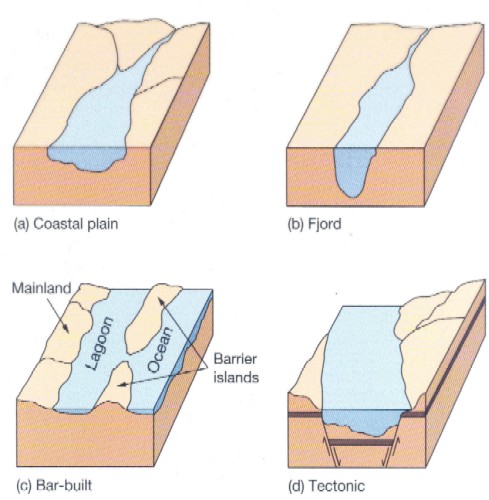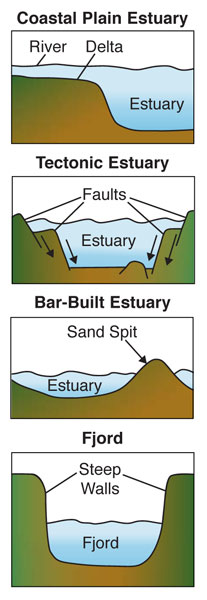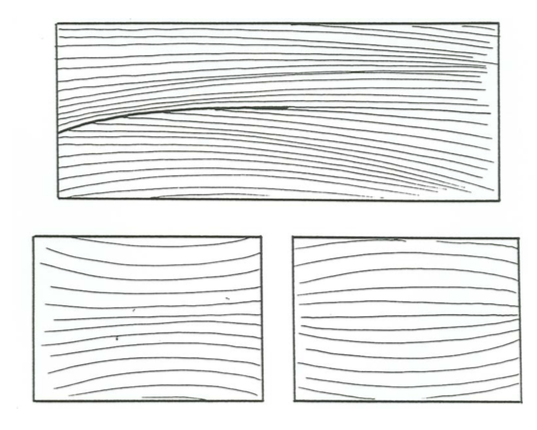Tides and Shallow Subtidal Environments
- Page ID
- 10883
\( \newcommand{\vecs}[1]{\overset { \scriptstyle \rightharpoonup} {\mathbf{#1}} } \)
\( \newcommand{\vecd}[1]{\overset{-\!-\!\rightharpoonup}{\vphantom{a}\smash {#1}}} \)
\( \newcommand{\dsum}{\displaystyle\sum\limits} \)
\( \newcommand{\dint}{\displaystyle\int\limits} \)
\( \newcommand{\dlim}{\displaystyle\lim\limits} \)
\( \newcommand{\id}{\mathrm{id}}\) \( \newcommand{\Span}{\mathrm{span}}\)
( \newcommand{\kernel}{\mathrm{null}\,}\) \( \newcommand{\range}{\mathrm{range}\,}\)
\( \newcommand{\RealPart}{\mathrm{Re}}\) \( \newcommand{\ImaginaryPart}{\mathrm{Im}}\)
\( \newcommand{\Argument}{\mathrm{Arg}}\) \( \newcommand{\norm}[1]{\| #1 \|}\)
\( \newcommand{\inner}[2]{\langle #1, #2 \rangle}\)
\( \newcommand{\Span}{\mathrm{span}}\)
\( \newcommand{\id}{\mathrm{id}}\)
\( \newcommand{\Span}{\mathrm{span}}\)
\( \newcommand{\kernel}{\mathrm{null}\,}\)
\( \newcommand{\range}{\mathrm{range}\,}\)
\( \newcommand{\RealPart}{\mathrm{Re}}\)
\( \newcommand{\ImaginaryPart}{\mathrm{Im}}\)
\( \newcommand{\Argument}{\mathrm{Arg}}\)
\( \newcommand{\norm}[1]{\| #1 \|}\)
\( \newcommand{\inner}[2]{\langle #1, #2 \rangle}\)
\( \newcommand{\Span}{\mathrm{span}}\) \( \newcommand{\AA}{\unicode[.8,0]{x212B}}\)
\( \newcommand{\vectorA}[1]{\vec{#1}} % arrow\)
\( \newcommand{\vectorAt}[1]{\vec{\text{#1}}} % arrow\)
\( \newcommand{\vectorB}[1]{\overset { \scriptstyle \rightharpoonup} {\mathbf{#1}} } \)
\( \newcommand{\vectorC}[1]{\textbf{#1}} \)
\( \newcommand{\vectorD}[1]{\overrightarrow{#1}} \)
\( \newcommand{\vectorDt}[1]{\overrightarrow{\text{#1}}} \)
\( \newcommand{\vectE}[1]{\overset{-\!-\!\rightharpoonup}{\vphantom{a}\smash{\mathbf {#1}}}} \)
\( \newcommand{\vecs}[1]{\overset { \scriptstyle \rightharpoonup} {\mathbf{#1}} } \)
\( \newcommand{\vecd}[1]{\overset{-\!-\!\rightharpoonup}{\vphantom{a}\smash {#1}}} \)
\(\newcommand{\avec}{\mathbf a}\) \(\newcommand{\bvec}{\mathbf b}\) \(\newcommand{\cvec}{\mathbf c}\) \(\newcommand{\dvec}{\mathbf d}\) \(\newcommand{\dtil}{\widetilde{\mathbf d}}\) \(\newcommand{\evec}{\mathbf e}\) \(\newcommand{\fvec}{\mathbf f}\) \(\newcommand{\nvec}{\mathbf n}\) \(\newcommand{\pvec}{\mathbf p}\) \(\newcommand{\qvec}{\mathbf q}\) \(\newcommand{\svec}{\mathbf s}\) \(\newcommand{\tvec}{\mathbf t}\) \(\newcommand{\uvec}{\mathbf u}\) \(\newcommand{\vvec}{\mathbf v}\) \(\newcommand{\wvec}{\mathbf w}\) \(\newcommand{\xvec}{\mathbf x}\) \(\newcommand{\yvec}{\mathbf y}\) \(\newcommand{\zvec}{\mathbf z}\) \(\newcommand{\rvec}{\mathbf r}\) \(\newcommand{\mvec}{\mathbf m}\) \(\newcommand{\zerovec}{\mathbf 0}\) \(\newcommand{\onevec}{\mathbf 1}\) \(\newcommand{\real}{\mathbb R}\) \(\newcommand{\twovec}[2]{\left[\begin{array}{r}#1 \\ #2 \end{array}\right]}\) \(\newcommand{\ctwovec}[2]{\left[\begin{array}{c}#1 \\ #2 \end{array}\right]}\) \(\newcommand{\threevec}[3]{\left[\begin{array}{r}#1 \\ #2 \\ #3 \end{array}\right]}\) \(\newcommand{\cthreevec}[3]{\left[\begin{array}{c}#1 \\ #2 \\ #3 \end{array}\right]}\) \(\newcommand{\fourvec}[4]{\left[\begin{array}{r}#1 \\ #2 \\ #3 \\ #4 \end{array}\right]}\) \(\newcommand{\cfourvec}[4]{\left[\begin{array}{c}#1 \\ #2 \\ #3 \\ #4 \end{array}\right]}\) \(\newcommand{\fivevec}[5]{\left[\begin{array}{r}#1 \\ #2 \\ #3 \\ #4 \\ #5 \\ \end{array}\right]}\) \(\newcommand{\cfivevec}[5]{\left[\begin{array}{c}#1 \\ #2 \\ #3 \\ #4 \\ #5 \\ \end{array}\right]}\) \(\newcommand{\mattwo}[4]{\left[\begin{array}{rr}#1 \amp #2 \\ #3 \amp #4 \\ \end{array}\right]}\) \(\newcommand{\laspan}[1]{\text{Span}\{#1\}}\) \(\newcommand{\bcal}{\cal B}\) \(\newcommand{\ccal}{\cal C}\) \(\newcommand{\scal}{\cal S}\) \(\newcommand{\wcal}{\cal W}\) \(\newcommand{\ecal}{\cal E}\) \(\newcommand{\coords}[2]{\left\{#1\right\}_{#2}}\) \(\newcommand{\gray}[1]{\color{gray}{#1}}\) \(\newcommand{\lgray}[1]{\color{lightgray}{#1}}\) \(\newcommand{\rank}{\operatorname{rank}}\) \(\newcommand{\row}{\text{Row}}\) \(\newcommand{\col}{\text{Col}}\) \(\renewcommand{\row}{\text{Row}}\) \(\newcommand{\nul}{\text{Nul}}\) \(\newcommand{\var}{\text{Var}}\) \(\newcommand{\corr}{\text{corr}}\) \(\newcommand{\len}[1]{\left|#1\right|}\) \(\newcommand{\bbar}{\overline{\bvec}}\) \(\newcommand{\bhat}{\widehat{\bvec}}\) \(\newcommand{\bperp}{\bvec^\perp}\) \(\newcommand{\xhat}{\widehat{\xvec}}\) \(\newcommand{\vhat}{\widehat{\vvec}}\) \(\newcommand{\uhat}{\widehat{\uvec}}\) \(\newcommand{\what}{\widehat{\wvec}}\) \(\newcommand{\Sighat}{\widehat{\Sigma}}\) \(\newcommand{\lt}{<}\) \(\newcommand{\gt}{>}\) \(\newcommand{\amp}{&}\) \(\definecolor{fillinmathshade}{gray}{0.9}\)Tides, Waves, and Ocean Currents

Figure 1: Components of a Wave (Modified by PW from Steven Earle “Physical Geology”.)
Tides, waves and currents play an important role in shaping and influencing the creation of subtidal environments of our modern coastal beaches, estuaries and lagoons. Interactive factors that influence subtidal environments are tides, waves, and ocean currents.
Waves are a form of energy that is being transmitted. Water move as a reaction to this energy in orbital motions creating the physical components of a wave as seen in Figure 1 (1). As the wave moves, water moves forward and up over wave crests and down into the troughs (1). Shallow water waves occur when the depth is less than 1/20 of a wavelength(1). In shallow waves, the wave base connects with the sea floor changing their motion from orbital to horizontal (1).
The alternating advance and retreat of seawater along the coast, rivers and lakes are called tides. Tides are driven by a combination of gravity fields of the sun and moon in addition to the Coriolis effect. High tide is when water advances to its furthest extent and low tides is when it recedes to its furthest extent. Tides are susceptible to change in sea levels.
Tidal flats or mudflats form where tides alternately flood and expose low areas along the coast (4). Typically tidal flats are broken into three different sections, which may be abundant or absent in each individual tidal flat: Supratidal, Intertidal, and subtidal (4). Subtidal environments have a wide distribution of facies associated with water depth and tidal and wave energy. Subtidal environments are important in understanding depositional environments as they are areas where facies are more likely to be preserved.
Sediment Transport and Deposition in Subtidal Environments
In subtidal environments, processes of sediment transport are widely influenced by three factors: initiation of motion (erosion), transport, and deposition. These shallow marine environments are regulated by water-level fluctuation. Grain sizes in subtidal environments range from medium sand to clay. Because of these dominant grain sizes, sediment transport in suspension is an important mode of transportation (2). Larger, coarser sediments are transported as bedload (2).
As flow intensity increases, more sediment is suspended within the water column. However, the frequent and rapid reversing of flow or tides results in the most commonly observed sedimentary structure, herringbone cross-stratification (2). Additionally, a fluctuating bed shear stress for erosion and deposition caused by the increasing and decreasing flow of tides, also causes scouring and settling lags. These tidal and erosional forces creates various types of depositional subtidal environments such as sand bars, spits, tidal flats, and dunes (2).
Subtidal Environments

Figure 2: General diagram of a tidal flat and associated features.
Subtidal environments that are formed along the coast, between land and sea or at river mouths, show various characteristics that define a constantly changing current and rely on a high sediment supply. Tidal magnitude can vary depending on the size and area of its channel, such as a tide entering through a funnel-shaped estuary. These tides and waves influence estuaries and deltas, creating various depositional environments (2). Estuaries are coastal bodies of water where freshwater and seawater mix (3). Estuaries are typically connected to the sea and are strongly influenced by tides (3).They can be composed of fine grain sediments transported by rivers or deltas (2). Furthermore, long term alternations in wave direction can further erode and deposit sediments in these subtidal environments. These alternating waves driven by high and low tides, can cause variations in bed and lamina thickness (2).


Figure 3: Types of Estuaries (5)
Subtidal Facies
During storms or other events that alter sea level, these subtidal environments are exposed to high energy tides, waves and storm impacts. They become lower and sediment grains begin to show upwards fining, as larger grains are brought in by waves (2). Fining upwards of sediments consists of coarse sediments at the base and progressively finger sediments at the top in an uninterrupted vertical sequence (2). Typically, a fining-upward succession reflects a decrease in energy as the environment changes from subtidal to intertidal. Other sedimentary structures that can be observed within these subtidal environments are hummocky cross stratification (2). These hummocky cross stratifications are good indicators of a wave-dominated tidal flats produced by alternating tide directions over a single tidal cycle (2).

Figure 4: Hummocky cross stratification (6)
Sources:
2. Davis, R.A., Dalrymple, R.W., Principles of Tidal Sedimentology, 2012. Springer Science Journal. https://books.google.com/books?hl=en&lr=&id=hyuIYTTjFL4C&oi=fnd&pg=PR3&dq=tidal+influences+in+subtidal+environments&ots=FTbUZaDBpL&sig=B5spLd6IBiT2YHyuc6vBgCVjNSE#v=onepage&q&f=true

